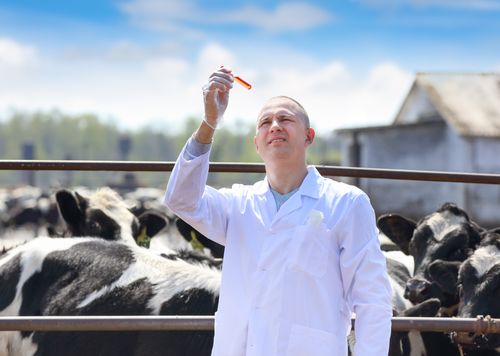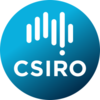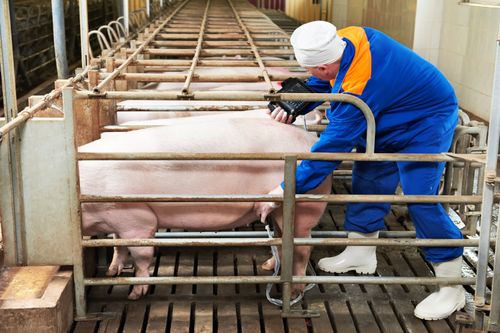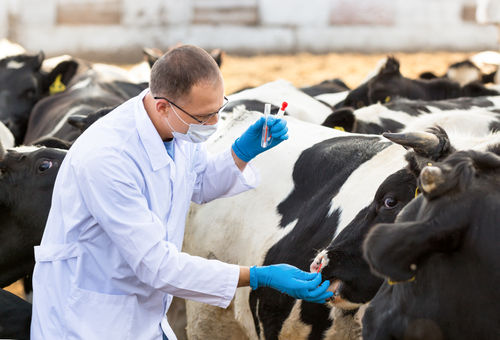OIE Collaborating Centre for Diagnostic Test Validation Science in the Asia-Pacific Region

The World Organisation for Animal Health (OIE) Collaborating Centre for Diagnostic Test Validation Science in the Asia-Pacific Region is a joint initiative of the CSIRO Australian Animal Health Laboratory (AAHL), the Faculty of Science of the University of Melbourne and the EpiCentre, Institute of Veterinary and Biomedical Sciences, Massey University, New Zealand.
Mission statement
The Centre’s mission is to generate new knowledge and techniques that improve the use and interpretation of diagnostic tests used in human and animal health and to promote dissemination of that knowledge to the wider medical and veterinary communities.
Terms of reference
The Centre’s terms of reference are as follows:
- To provide services to the OIE, in particular within the region, in the designated specialty, in support of the science-based development and implementation of OIE policies and, where required, seek for collaboration with OIE Reference Laboratories;
- To propose or develop methods and procedures that facilitate harmonisation of international standards and guidelines applicable to the designated specialty;
- To carry out and/or coordinate scientific and technical studies in collaboration with other centres, laboratories or organisations;
- To collect, process, analyse, publish and disseminate data and information relevant to the designated specialty;
- To provide, within the designated specialty, scientific and technical training to personnel from OIE Member Countries;
- To organise and participate in scientific meetings and other activities on behalf of the OIE;
- To identify and maintain existing expertise, in particular within its region;
- To establish and maintain a network with other OIE Collaborating Centres designated for the same specialty, and should the need arise, with Collaborating Centres in other disciplines;
- To place expert consultants at the disposal of the OIE.




Teaching
Staff across our three institutions have a broad range of experience in laboratory diagnostic methods, epidemiology and biostatistics. We combine a high level of technical expertise with wide-ranging practical experience to provide training opportunities that cover the fundamentals and theory of diagnostic test validation science as well as application of these methods in a practical setting.
Post graduate training opportunities
Please contact us if you are interested in postgraduate research opportunities in diagnostic test validation science.
Contact
For research higher degree applications, please visit: http://fvas.unimelb.edu.au/research/graduate-research
Upcoming events
July 2018
Australian and New Zealand College of Veterinary Scientists Science Week.
12-16 Nov 2018
International Society for Vet Epidemiology and Economics 15, Chaing Mai, Thailand.
Nov 2018
Australian Association of Veterinary Laboratory Diagnosticians Annual Conference.
Please see Publications tab for reference papers covering the basics of diagnostic tests and diagnostic test validation in the absence of a gold standard.
Tools and software
Click here to access the Bayesian Epidemiologic Screening Techniques web site at the University of California Davis.
Betabuster in R (epiR∷betabuster):A Shiny version of Wes Johnson and Chun-Lung Su's Betabuster (parameterising beta distributions with elicited values).
bamdit: Bayesian meta-analysis of diagnostic test data.
bcROCsurface: Bias-corrected methods for estimating the ROC surface of continuous diagnostic tests.
bdpv: Inference and design for predictive values in binary diagnostic tests.
DTComPair: Comparison of binary diagnostic tests in a paired study design.
epiR: Tools for the analysis of epidemiological data.
GsymPoint: Estimation of the generalized symmetry point, an optimal cutpoint in continuous diagnostic tests.
HSROC: Meta-analysis of diagnostic test accuracy when the reference test is imperfect.
icensmis: Study design and data analysis in the presence of error-prone diagnostic tests and self-reported outcomes.
mada: Meta-analysis of diagnostic accuracy.
meta4diag: Meta-analysis for diagnostic test studies.
An online tool to assist with prior elicitation from subject matter experts by Anthony Charsley and Geoff Jones (Massey University).
Links
CSIRO Australian Animal Health Laboratory (AAHL), Geelong, Australia.
Veterinary Epidemiology @ Melbourne, Faculty of Veterinary and Agricultural Sciences, the University of Melbourne, Australia.
The EpiCentre, Massey University, New Zealand.
Graduate Group in Epidemiology, School of Veterinary Medicine, University of California, Davis.
Veterinary Epidemiology, Economics and Public Health, Royal Veterinary College.
Centre for Veterinary Epidemiological Research, University of Prince Edward Island, Canada.
Ausvet Animal Health Services, Australia.
Centre publications
Colling A, Morrissy C, Barr J, Meehan G, Wright L, Goff W, Gleeson L, van der Heide B, Riddell S, Yu M, Eagles D, Lunt R, Khounsy S, Than Long N, Phong Vu P, Than Phuong N, Tung N, Linchongsubongkoch W, Hammond J, Johnson M, Johnson W, Unger H, Daniels P, Crowther J (2014). Development and validation of a 3ABC antibody ELISA in Australia for foot and mouth disease. Australian Veterinary Journal 92, 192-199.
Muleme M, Stenos J, Vincent G, Campbell A, Graves S, Warner S, Devlin J, Nguyen C, Stevenson M, Wilks C, Firestone S (2016). Bayesian validation of the indirect immunofluorescence assay and its superiority to the enzyme-linked immunosorbent assay and the complement fixation test for detecting antibodies against Coxiella burnetii in goat serum. Clinical Vaccine Immunology 23, 507-514.
Pirikahu S, Jones G, Hazelton M, Heuer C (2016). Bayesian methods of confidence interval construction for the population attributable risk from cross-sectional studies. Statistics in Medicine 35, 3117-3130.
Gebrekidan H, Gasser R, Stevenson M, McGrath S, Jabbar A (2016). Assessing the performance of multiplexed tandem PCR for the diagnosis of pathogenic genotypes of Theileria orientalis using pooled blood samples from cattle. Molecular and Cellular Probes DOI: 10.1016/j.mcp.2016.06.005
Van Borm S, Wang J, Granberg F, Colling A (2016). Next generation sequencing workflows in veterinary infection biology: Towards validation and quality assurance. Revue Scientifique et Technique de l'Office International des Epizooties 35, 67-81.
Wawagama N, Markham P, Kanci A, Schibrowski M, Oswin M, Barnes T, Firestone S, Mahony T (2016). Evaluation of an IgG enzyme-linked immunosorbent assay as a serological assay for detection of Mycoplasma bovis infection in feedlot cattle. Journal of Clinical Microbiology 54, 1269-1275.
Roeber F, Hassan EB, Skuce P, Morrson A, Claerebaout E, Casaert S, Homer D, Firestone S, Stevenson M, Smith L, Larsen J (2017). An automated, multiplex-tandem PCR platform for diagnosis of gastrointestinal nematode infections in cattle: An Australian-European validation study. Veterinary Parasitology 239, 62-75.
Reference papers
Useful papers covering the basics of diagnostic tests and diagnostic test validation in the absence of a gold standard:
Akobeng K (2007). Understanding diagnostic tests 1: sensitivity, specificity and predictive values. Acta Paediatrica. 96: 338-341.
Bossuyt P, Reitsma J, Bruns D, Gatsonis C, Glasziou P, Irwig L, Lijmer J, Moher D, Rennie D and de Vet H (2003). Towards complete and accurate reporting of studies of diagnostic accuracy: The STARD initiative. Clinical Chemistry. 49: 1-6.
Collins M, Wells S, Petrini K, Collins J, Schultz R, Whitlock R (2005). Evaluation of five antibody detection tests for diagnosis of bovine paratuberculosis. Clinical and Diagnostic Laboratory Immunology. 12: 685-692.
Coulthard M (2007). Quantifying how tests reduce diagnostic uncertainty. Archives of Disease in Childhood. 92: 404-408.
Davidson M (2002). The interpretation of diagnostic tests: a primer for physiotherapists. Australian Journal of Physiotherapy. 48: 227-233.
Enøe C, Georgiadisb M, Johnson W (2001). Estimation of sensitivity, specificity and predictive values of two serological tests for the detection of antibodies against Actinobacillus pleuropneumoniae serotype 2 in the absence of a reference test (gold standard). Preventive Veterinary Medicine. 51: 227-243.
Enøe C, Georgiadisb M, Johnson W (2000). Estimation of sensitivity and specificity of diagnostic tests and disease prevalence when the true disease state is unknown. Preventive Veterinary Medicine. 45: 61-81.
Frössling J, Bonnett B, Lindberg A, Bjorkman C (2003). Validation of a Neosporum caninum iscom ELISA without a gold standard. Preventive Veterinary Medicine. 57: 141-153.
Gardner IA (2002). The utility of Bayes' theorem and Bayesian inference in veterinary clinical practice and research. Australian Veterinary Journal. 80: 758-761.
Greiner M, Gardner I (2000a). Epidemiologic issues in the validation of veterinary diagnostic tests. Preventive Veterinary Medicine. 45: 3-22.
Greiner M, Gardner I (2000b). Application of diagnostic tests in veterinary epidemiologic studies. Preventive Veterinary Medicine. 45: 43-59.
Grimes D, Schulz K (2002). Uses and abuses of screening tests. The Lancet. 359: 881-884.
Kostoulas P, Nielsen SS, Branscum AJ, Johnson WO, Dendukuri N, Dhand NK, Toft N, Gardner IA, (2017). Laboratory STARD-BLCM: Standards for the reporting of diagnostic accuracy studies that use Bayesian latent class models. Preventive Veterinary Medicine. 138: 37-47.
Langlotz C (2003). Fundamental measures of diagnostic examination performance: Usefulness for clinical decision making and research. Radiology. 228: 3-9.
McKenna S, Dohoo I (2006). Using and interpreting diagnostic tests. Veterinary Clinics of North America Food Animal Practice. 22: 195-205.
Pouillot R, Gerbier G, Gardner I (2002). "TAGS", a program for the evaluation of test accuracy in the absence of a gold standard. Preventive Veterinary Medicine. 53: 67-81.
Scott I, Greenberg P, Poole P (2008). Cautionary tales in the clinical interpretation of studies of diagnostic tests. Internal Medicine Journal. 38: 120-129.
Taragin M, Wildman D, Trout R (1994). Assessing disease prevalence from inaccurate test results: Teaching an old dog new tricks. Medical Decision Making. 14: 369-373.

Mark Stevenson
University of Melbourne
mark.stevenson1@unimelb.edu.au
Simon Firestone
University of Melbourne
simon.firestone@unimelb.edu.au
Anke Wiethoelter
University of Melbourne
anke.wiethoelter@unimelb.edu.au
Axel Colling
CSIRO
axel.colling@csiro.au
Kim Halpin
CSIRO
kim.halpin@csiro.au
Cord Heuer
Massey University
c.heuer@massey.ac.nz